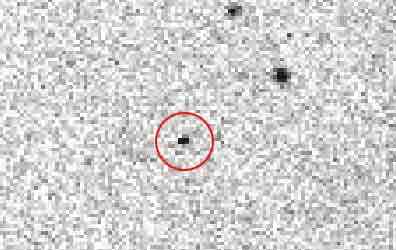Callirrhoe (moon)
| Callirrhoe | |
|---|---|

|
|
| Callirrhoe discovery picture on October 19, 1999 | |
| Provisional or systematic name | S / 1999 J 1 |
| Central body | Jupiter |
| Properties of the orbit | |
| Major semi-axis | 24,102,000 km |
| Periapsis | 17,281,000 km |
| Apoapsis | 30,923,000 km |
| eccentricity | 0.283 |
| Orbit inclination | 147.1 ° |
| Orbital time | 758.8 d |
| Mean orbital velocity | 2.29 km / s |
| Physical Properties | |
| Albedo | 0.04 |
| Apparent brightness | 20.8 mag |
| Medium diameter | 7 km |
| Dimensions | 869.227.691.196.372 kg |
| Medium density | 2.6 g / cm 3 |
| Acceleration of gravity on the surface | ≈ 0 m / s 2 |
| Escape speed | ≈ 0 m / s |
| discovery | |
| Explorer |
Jim V. Scotti, Timothy B. Spahr, Robert S. McMillan, Jeffrey A. Larsen, Joe Montani, Arianna E. Gleason, and Tom Gehrels |
| Date of discovery | October 19, 1999 |
Callirrhoe (also Jupiter XVII) is one of the outermost moons of the planet Jupiter .
discovery
Callirrhoe was discovered on October 19, 1999 by astronomers Jim V. Scotti , Timothy B. Spahr , Robert S. McMillan , Jeffrey A. Larsen , Joe Montani , Arianna E. Gleason and Tom Gehrels with a 36-inch telescope at Kitt- Peak National Observatory discovered as part of the University of Arizona's Spacewatch program . At first the celestial body was thought to be an asteroid (1999 UX 18 ). Timothy B. Spahr determined on July 18, 2000 that it was another Jupiter moon, which was then given the provisional designation S / 1999 J 1.
The moon was named after Kallirhoe , the mother of Ganymede from Greek mythology .
Orbit data
Callirrhoe orbits Jupiter at a mean distance of 24,102,000 km in about 759 days. The track has an eccentricity of 0.283. With an inclination of 147.1 °, the orbit is retrograde; that is, the moon moves around the planet against the direction of rotation of Jupiter.
Callirrhoe is attributed to the Pasiphae group due to its web characteristics .
Physical data
Callirrhoe has a mean diameter of about 7 km (with an equatorial radius of 4.3 km). The density is estimated very roughly at 2.6 g / cm³, because the moon is probably made up mainly of silicate rock. Callirrhoe has a very dark surface with an albedo of 0.04, i.e. that is, only 4% of the incident sunlight is reflected. Their apparent brightness is 20.8 m .
Web links
- IAUC 7460: S / 1999 J 1 July 20, 2000 (discovery)
- MPEC 2000-Y16: S / 1975 J 1 = S / 2000 J 1, S / 1999 J 1 December 19, 2000 (orbital elements and ephemeris)
- IAUC 7998: Satellites of Jupiter October 22, 2002 (numbering and naming)
- https://solarsystem.nasa.gov/planets/callirrhoe/facts
Individual evidence
- ↑ By the Numbers | Callirrhoe. Retrieved July 2, 2020 .
| before | Jupiter moons | after that |
| Metis | Callirrhoe |
Themisto |